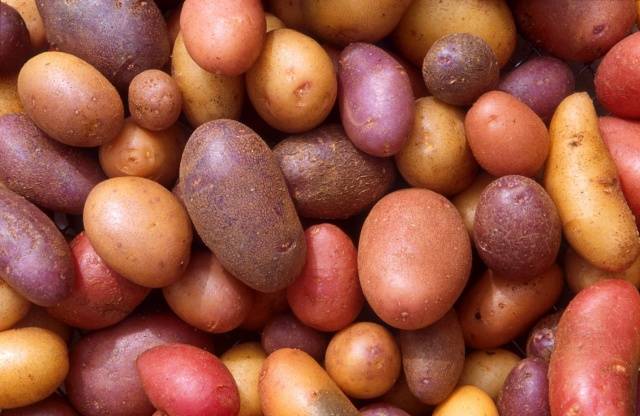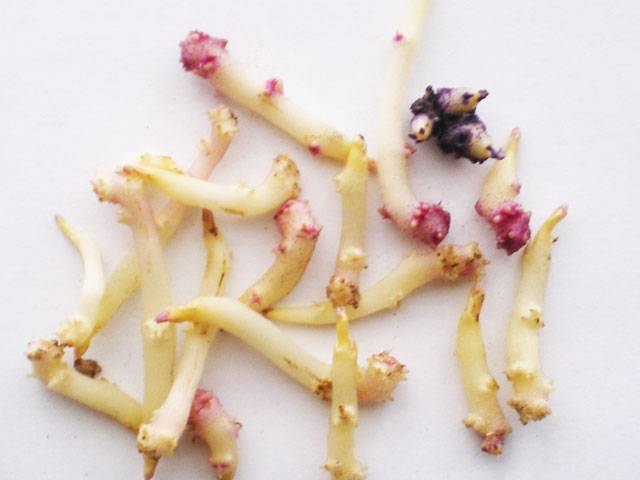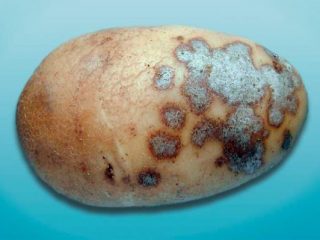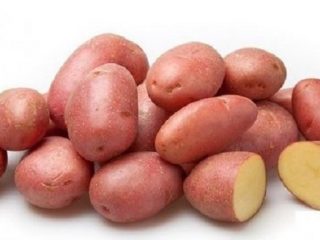Content
- 1 Germination of tubers
- 1.1 When to start pre-planting preparations
- 1.2 What tubers to take for planting
- 1.3 Preparing tubers for germination
- 1.4 Conditions for germination
- 1.5 Greening of tubers
- 1.6 Methods for germinating tubers
- 1.7 Potatoes are overgrown
- 1.8 How to treat potatoes during germination
- 1.9 How to speed up tuber germination
- 2 Improvement of planting material
- 3 Conclusion
Second bread potato they are called for a reason. It occupies one of the main places in our diet. Potatoes are boiled, fried, stewed, and are an essential ingredient in the preparation of soups, borscht, cabbage soup, and vinaigrettes. It is used to make chips, filling for baked goods, and baked. In our country, starch is made from potatoes.
Even those summer residents who buy this vegetable due to lack of land plant at least a few dozen bushes to enjoy early potatoes. But it often happens that the result does not please us. We blame the weather, late blight, and the Colorado potato beetle, but we rarely think that the poor harvests are largely our fault. In order for potatoes to produce well, you need to germinate them correctly, plant them in a suitable place and provide acceptable care. The topic of our today's article will be preparing and sprouting potatoes before boarding.
Germination of tubers
Before planting potato tubers in the ground, they need to be germinated. Of course, you can plant them without eyes, but this will delay the harvest by at least 2 weeks. And in those areas where summers are short and cool, it is generally not recommended to plant unsprouted tubers. To ensure that our efforts are not in vain, let's do everything right.
When to start pre-planting preparations
You need to remove potatoes from the cellar or basement approximately 30-35 days before planting. We give a maximum period; if you plant only early varieties, you can remove the potatoes 5-7 days later.
If the eyes hatch well, but do not grow, do not rush to transfer the tubers to a warm place - there they will quickly grow and by the time of planting they will outgrow them, you will break them out, and you will have to wait for new shoots. It is better to wait a few days, lowering the temperature and adding lighting. Gardeners with even a little experience usually determine quite accurately by eye whether it is necessary to break out the sprouted eyes.
When planting potatoes, the soil should be warm. In the cold it will lie as if in a pantry until the soil warms up to 12-15 degrees.
What tubers to take for planting
Whatever the size of the potato tubers, if they are not rotten and have been previously germinated, they will all sprout. But the best yield comes from potatoes the size of a chicken egg, weighing about 100 g.
Large tubers
Large tubers have a large supply of nutrients. After planting, they will give quite satisfactory growth.But until all the reserves contained in the planting material are used up, the development of the root system will lag far behind the tops. When the old tuber gives up all its reserves, the underground part will be weak and will not be able to satisfy the demands of the above-ground part. Until the balance is restored, there can be no talk of any formation and development of tubers.
If you use large potatoes as planting material, cut them a few days before planting so that the cut can be tested.
Small tubers
If we take too small tubers for planting, the harvest will be meager. In order not to waste space, you will have to put 2-3 potatoes in one hole. Many people don’t see anything wrong with this, but those who have been involved in harvesting know how inconvenient it is to dig up such nests. You will definitely cut several tubers, and digging the soil once is not enough - so you have to dance over potatoes planted several at a time.
Preparing tubers for germination
How to cook tubers The article explains in detail before germinating potatoes.
Now we will only repeat the main steps:
- Wash the tubers, sort and warm them by pouring hot water at a temperature of 42-45 degrees;
- When the water has cooled, add a solution of potassium permanganate until it turns bright pink and leave for another 15 minutes;
- Treat the planting material with humates, biofungicides, stimulants or chemicals at your discretion.
Conditions for germination
There are many ways to sprout potatoes before planting. All of them involve keeping tubers at temperature at 12-15 degrees. Another mandatory requirement is that the room must be well ventilated.
Humidity and light should correspond to the method you chose for germinating tubers.
Greening of tubers
It is recommended to green the tubers before germinating potatoes for planting. Do this in a cool, well-lit place. If the sun is shining outside during the day and the temperature is above zero, you can take the container with planting material outside and bring it back in the evening.
When exposed to light, solanine is formed in potatoes, a poison that turns the tubers green, which is why the whole procedure is called “greening.” Solanine protects bushes after planting in the ground from many pests, in particular rodents. Its accumulation to the required concentration usually occurs within 20 days. After this, the planting material can be brought into a warmer room directly for germination.
Methods for germinating tubers
There are many ways to germinate tubers; we will remind you of the ones that are used most often. You can call them classic.
Germination in the dark
This is the simplest and most common way to sprout potatoes.It is simply placed in boxes or baskets and placed in a well-ventilated, dark place. If the temperature in the house is low, then the container can be placed under the bed - this way it won’t even take up space. Just ventilate the room more often.
When potatoes are sprouted this way, the sprouts turn out white and elongated. They need to be planted carefully.
Germination in the light
This method is much better than the previous one, but it requires a lot of well-lit space, so it is difficult to use when planting a large number of potatoes. The tubers are laid out in 2-3 layers near the windows so that light falls on them. The sprouts turn out green, strong and do not stretch. After 10-15 days, they need to be swapped so that the tubers located below are exposed to the light. Naturally, this will take some time.
Wet germination
Germinating tubers in a humid environment has a number of advantages - a bright room is not required and planting material can be kept in large boxes. In addition, not only sprouts are formed on the potatoes, but also roots, which will significantly speed up germination - after planting, the plant will quickly take root and begin to grow, therefore, we will get the harvest earlier.
You need to take any moisture- and breathable substrate:
- aerated peat;
- well-rotted humus;
- sawdust or tyrsa.
A layer of wet substrate is laid out at the bottom of the box, potatoes are laid out on it in one layer and covered with peat or sawdust. Then they repeat everything, but there is no need to lay out more than 4 layers of potatoes - this makes it difficult for air circulation. This is how the boxes will remain until the start of the planting season. From time to time, sprouting potatoes need to be moistened.
Pre-drying
We know how many days it takes to germinate potatoes. But it happens that for one reason or another we were not able to get it out of the basement in time. What should I do, should I plant unsprouted tubers? You need to spread them out in a thin layer in a dry room and dry them. The procedure lasts only a week and a half, sprouts will not appear on the tubers during this time, but the eyes will awaken and sprout friendly shoots.
Potatoes are overgrown
It happens, especially in warm winters, that potatoes in a cellar or basement germinate on their own when it is not yet time to start sprouting. The sprouts need to be broken off as early as possible so that they do not take nutrients from the tuber. Under favorable conditions, after 10-15 days a new bud emerges from the same eye.
But what should we do if we took out the planting material from the basement with good growth, but there is simply no time to wait for the buds to awaken again? There is only one way out - place the sprouted potatoes in a bright place with a temperature slightly below 10 degrees. Thus, the sprouts will stop growing, will not stretch, and will turn green in the light. It will need to be planted as early as possible, while being careful not to damage the shoots.
How to treat potatoes during germination
It’s great if you have time to spray the planting material once a week with humate, zircon or epinom. Treatment with phytosporin gives good results.If you are drying potatoes, you do not need to do this, and if you are germinating them in a damp substrate, do not spray them, but add one of the above preparations in a weak concentration to the water every time you water them.
There are many artificial stimulants on the market, but whether to use them is up to you.
How to speed up tuber germination
How to quickly germinate potatoes if time is lost? Wet germination of potatoes, described above, is the fastest and takes about 10 days. If you know that there will be little time in the spring, green the tubers in the fall. And be sure to water the planting with one of the preparations indicated in the previous chapter, adding root or heteroauxin according to the instructions.
Improvement of planting material
Every year we plant potatoes on the plot. Over time, harvests become worse:
- fewer and fewer tubers are in the nest;
- Every year the number of plants affected by viral diseases increases;
- taste quality decreases.
Why do potatoes degenerate?
We buy planting material at the market or from neighbors, and then complain: either the land is not the same, or the potatoes have degenerated. This is not far from the truth. Every year, tubers collect negative genetic material like a storeroom, and viral diseases also accumulate.
Tubers are not seeds, but modified parts of the stem. Growing potatoes from year to year, we propagate them, strictly speaking, by cuttings that carry all the positive and negative genetic (and not only) information of the mother plant. In fact, we grow the same plant.
To avoid this, you can buy seed material every year from specialized nurseries - you cannot buy good potatoes from your neighbors - they have their own problems, they also carry the burden of changes accumulated over the years, only different ones. But certified elite seed material costs so much that, looking at the price, we no longer want to update the variety or potatoes at all.
If you are satisfied with the varieties grown in the garden, and the only dissatisfaction is the yield and frequent infection with viral diseases, improve their health yourself.
Healthy potato sprouts
We take out the tubers selected for the improvement of planting material earlier than the rest of the potatoes, green them as described above, and germinate them in wet peat or sawdust at a temperature of 20-25 degrees. Very quickly the sprouts will reach a size of 5-7 cm. They need to be carefully broken out, planted in plastic cups or separate pots, buried 2/3 in the soil for seedlings and immediately placed in a bright place.
You need to care for potato sprouts in the same way as tomato seedlings. Plants need to be transferred into the ground when the soil warms up, at the same time as planting potato tubers. They will produce two or three large tubers - this will be healthy planting material for next year.
In the fall, the tubers need to be washed, kept in hot water and potassium permanganate, treated with phytosporin, dried and placed in the largest glass jars you have. Tie the necks of the jars with cloth (they cannot be covered with lids or plastic) and place them on the windowsill until spring. From time to time, the cans need to be turned relative to the light source.
In spring, the tubers need to be cut into several parts 2-3 days before planting, and no further additional processing is needed.
Obtaining planting material from seeds
Potato seeds are collected when the berries turn brown. They are dried and stored in paper bags until spring. They are sown for seedlings at the same time as tomatoes, grown, cared for and planted in exactly the same way.
In mid to late summer we will harvest small, bean-sized potatoes. They need to be stored in the lower section of the refrigerator or in the basement separately from the rest of the potatoes. Next spring it can be planted directly in the ground, or it can be grown through seedlings. It will provide good planting material for the next season.
Comment! You can find seeds of hybrid potatoes on sale - they produce a full harvest in the first year, but are not suitable for further breeding.
Conclusion
Watch the video that talks about germinating tubers before planting:
There are many methods for germinating potatoes, and all give good results. Choose the one that is most suitable for your conditions and will cause the least inconvenience. Have a good harvest!

























